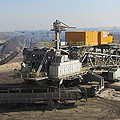HOW DOES MOBILE MINING EQUIPMENT WORK?
April 12, 2016
Engineers turn to every conceivable form of transportation when designing mobile mining equipment. The equipment, with a few notable exceptions, must function as well as its contemporary stationary cousin but must do so while navigating tough terrain. Big-wheeled roadsters with reinforced suspension frames dot this landscape, but there are also examples of large mining contrivances on rails and wide crawler tracks. Let’s take a closer look.
ON-BOARD POWER
Drive systems and mechanical processing assemblies draw power from an onboard diesel engine, perhaps more than one if the load is substantial. Current manufacturers are also testing environmentally friendly solutions by offering electric hookups in the form of overhead electric cables, trolley-type power supplies that work best when the equipment is on a rail. Hybrid systems access electricity on level ground, only switching to the overhead power supply when a tough slope is encountered.
SELF-LEVELLING CONTROLS
The screening process uses either a level or radically reduced incline to process coarse material. Similarly, water-processed material favours a flattened workspace. Self-levelling mechanisms use PLC (programmable logic controllers) to automatically adjust a hydraulically operated assemblage of large parts and maintain the permissible processing angle.
EMPLOYING EXISTING SOLUTIONS
A heavy-haul truck manages the hole-pocked terrain with determined efficiency, but complex mobile mining equipment, the devices built on massive scales, well, they need a designer-imbued strategy that will account for the processes taking place within the machinery. Thankfully, the same technology that has revolutionized the petrochemical sector is now being employed in the mining industry. The aforementioned PLC devices monitor vibrations and tune the suspension of mobile rigs to stop material loss. The railway industry and construction sector also contribute engineering advances in the form of twin rails and transmission assemblies that incorporate crawler tracks.
THE BIRTH OF INTEGRATED EQUIPMENT
It’s possible to have dozens of relatively small movers crawling around a mining facility, but this approach only hampers productivity and creates traffic. The solution is the incorporation of whole-system rigs, mobile mining equipment that places all of the mentioned processing stages on a single platform. Logistics issues are simplified by reducing traffic. Sensor packages add to the configuration by sending telemetry back to a central depot and enhances the synchronicity factor built into each processing platform.
Full in-pit processing takes place on these slow-moving rigs. Stability is assured, automated leveling is part of the system, and material screening, crushing, and sorting proceeds in much the same way as it does on a stationary setup.
Screening Technology Pty Ltd T/AS Hawk Machinery
Address: 7 Lantana St Blackburn North Vic 3130
Contact Person: Bohdan Blaszczyk
Phone: +61 3 9877 7777
Fax: +61 3 9877 8177
Mobile: 0411 099 989
Email: info@hawkmachinery.com.au
Optimized by NetwizardSEO.com.au
Optimized by: Netwizard SEO
